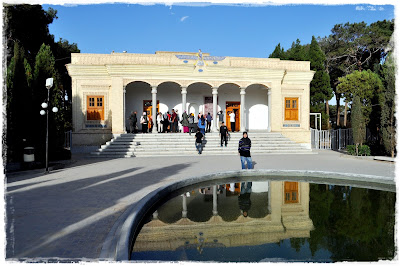"Don't underestimate small steps, it is only a small step which gets you closer to where you want to be tomorrow..."


TRACING THE PERSIAN SILK ROUTE
Date: 7 – 21 March 2016
Route: Tehran – Kerman – Yazd – Shiraz – Isfahan – Tabriz
Date: 7 – 21 March 2016
Route: Tehran – Kerman – Yazd – Shiraz – Isfahan – Tabriz
Because of long standing history of coups, espionage, nuclear sanctions and everything else in between, hubby and I decided to join a large Safir tour group to visit Iran. You would be surprised that travelling to Iran is quite safe and Iranians are very friendly and hospitable.
With a 2-weeks packed itinerary, we were on a nomadic state most of the time, moving from one town to another and visited a lot of interesting historical sites of Persian ancient civilization. Many were not exactly that well-trodden and not easily accessible by public transport.
Iran is also an important constituent of the Ancient Silk Road. This trip is our effort in tracing the Ancient Silk Route where international trade was crucial for Sassanid Persians developed basically from the beginning of the century. The branch of imperial road starting in Herat, Afghanistan led northward to Merv and further to Samarkand where that road possibly merged with the Silk Road from China across the oases of Eastern Turkestan.
The area of Asia Minor and Syria was connected with the Silk Road by overland road leading along the Euphrates to the harbors of the Persian Gulf, or by ancient caravan route from Syria across Iran. Even though the modern territory of Iran is only a part of what used to be the vast Sassanid Empire, it still has a number of monuments connected with that international artery.
My travelogue in Iran:
Day 01: KL - Tehran
Day 02: Tehran - Kerman
Day 03: Kerman
Day 04: Kerman - Yazd
Day 05: Yazd - Shiraz
Day 06: Shiraz - Isfahan
Day 07: Isfahan
Day 08: Isfahan - Tehran
Day 09: Tehran - Tabriz
Day 10: Tabriz
Day 11: Tabriz - Tehran
Day 12: Tehran
Day 13: Tehran
Day 14: Tehran - KL
Our next trip will be cruising on the Aegean Sea and islands hopping to a few Greek islands and visiting beautiful towns in Turkey, insya-Allah...
With a 2-weeks packed itinerary, we were on a nomadic state most of the time, moving from one town to another and visited a lot of interesting historical sites of Persian ancient civilization. Many were not exactly that well-trodden and not easily accessible by public transport.
Iran is also an important constituent of the Ancient Silk Road. This trip is our effort in tracing the Ancient Silk Route where international trade was crucial for Sassanid Persians developed basically from the beginning of the century. The branch of imperial road starting in Herat, Afghanistan led northward to Merv and further to Samarkand where that road possibly merged with the Silk Road from China across the oases of Eastern Turkestan.
The area of Asia Minor and Syria was connected with the Silk Road by overland road leading along the Euphrates to the harbors of the Persian Gulf, or by ancient caravan route from Syria across Iran. Even though the modern territory of Iran is only a part of what used to be the vast Sassanid Empire, it still has a number of monuments connected with that international artery.
My travelogue in Iran:
Day 01: KL - Tehran
Day 02: Tehran - Kerman
Day 03: Kerman
Day 04: Kerman - Yazd
Day 05: Yazd - Shiraz
Day 06: Shiraz - Isfahan
Day 07: Isfahan
Day 08: Isfahan - Tehran
Day 09: Tehran - Tabriz
Day 10: Tabriz
Day 11: Tabriz - Tehran
Day 12: Tehran
Day 13: Tehran
Day 14: Tehran - KL
 |
| (Imam Khomeini Shrine in Tehran) |
 |
| (Rayen Citadel in Kerman) |
 |
| (Zoroastrian Fire Temple in Yazd) |
 |
| (The Persepolis ruins in Shiraz) |
 |
| (Iman Khomeini Square in Isfahan) |
 |
| (The Boroujerdi House in Kashan) |
 |
| (Colorful landscape from Zanjan to Tabriz) |
 |
| (Lake Urmia in Tabriz) |
 |
| (Hujjatul Islam Mosque in Tabriz Bazaar) |
 |
| (The National Museum of Tehran) |
Our next trip will be cruising on the Aegean Sea and islands hopping to a few Greek islands and visiting beautiful towns in Turkey, insya-Allah...
Next Trip: 2016 The Aegean Sea Cruise and Turkey Tour
































































